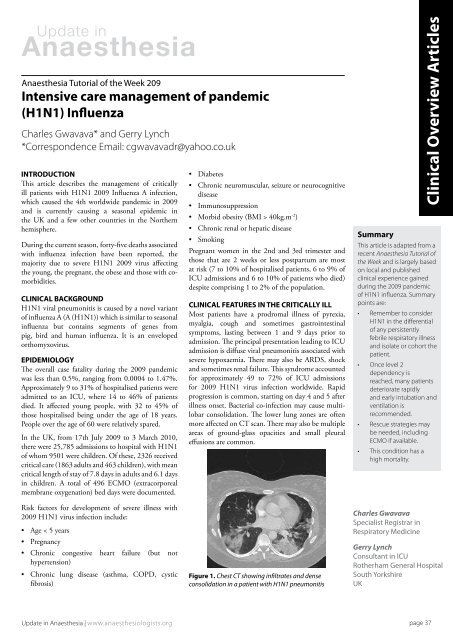Surgically placed rectus sheath catheters - The Global Regional ...
Surgically placed rectus sheath catheters - The Global Regional ...
Surgically placed rectus sheath catheters - The Global Regional ...
Create successful ePaper yourself
Turn your PDF publications into a flip-book with our unique Google optimized e-Paper software.
Update in<br />
Anaesthesia<br />
Anaesthesia Tutorial of the Week 209<br />
Intensive care management of pandemic<br />
(H1N1) Influenza<br />
Charles Gwavava* and Gerry Lynch<br />
*Correspondence Email: cgwavavadr@yahoo.co.uk<br />
INTRODUCTION<br />
This article describes the management of critically<br />
ill patients with H1N1 2009 Influenza A infection,<br />
which caused the 4th worldwide pandemic in 2009<br />
and is currently causing a seasonal epidemic in<br />
the UK and a few other countries in the Northern<br />
hemisphere.<br />
During the current season, forty-five deaths associated<br />
with influenza infection have been reported, the<br />
majority due to severe H1N1 2009 virus affecting<br />
the young, the pregnant, the obese and those with comorbidities.<br />
CLINICAL BACKGROUND<br />
H1N1 viral pneumonitis is caused by a novel variant<br />
of influenza A (A (H1N1)) which is similar to seasonal<br />
influenza but contains segments of genes from<br />
pig, bird and human influenza. It is an enveloped<br />
orthomyxovirus.<br />
EPIDEMIOLOGY<br />
<strong>The</strong> overall case fatality during the 2009 pandemic<br />
was less than 0.5%, ranging from 0.0004 to 1.47%.<br />
Approximately 9 to 31% of hospitalised patients were<br />
admitted to an ICU, where 14 to 46% of patients<br />
died. It affected young people, with 32 to 45% of<br />
those hospitalised being under the age of 18 years.<br />
People over the age of 60 were relatively spared.<br />
In the UK, from 17th July 2009 to 3 March 2010,<br />
there were 25,785 admissions to hospital with H1N1<br />
of whom 9501 were children. Of these, 2326 received<br />
critical care (1863 adults and 463 children), with mean<br />
critical length of stay of 7.8 days in adults and 6.1 days<br />
in children. A total of 496 ECMO (extracorporeal<br />
membrane oxygenation) bed days were documented.<br />
• Diabetes<br />
• Chronic neuromuscular, seizure or neurocognitive<br />
disease<br />
• Immunosuppression<br />
• Morbid obesity (BMI > 40kg.m -2 )<br />
• Chronic renal or hepatic disease<br />
• Smoking<br />
Pregnant women in the 2nd and 3rd trimester and<br />
those that are 2 weeks or less postpartum are most<br />
at risk (7 to 10% of hospitalised patients, 6 to 9% of<br />
ICU admissions and 6 to 10% of patients who died)<br />
despite comprising 1 to 2% of the population.<br />
CLINICAL FEATURES IN THE CRITICALLY ILL<br />
Most patients have a prodromal illness of pyrexia,<br />
myalgia, cough and sometimes gastrointestinal<br />
symptoms, lasting between 1 and 9 days prior to<br />
admission. <strong>The</strong> principal presentation leading to ICU<br />
admission is diffuse viral pneumonitis associated with<br />
severe hypoxaemia. <strong>The</strong>re may also be ARDS, shock<br />
and sometimes renal failure. This syndrome accounted<br />
for approximately 49 to 72% of ICU admissions<br />
for 2009 H1N1 virus infection worldwide. Rapid<br />
progression is common, starting on day 4 and 5 after<br />
illness onset. Bacterial co-infection may cause multilobar<br />
consolidation. <strong>The</strong> lower lung zones are often<br />
more affected on CT scan. <strong>The</strong>re may also be multiple<br />
areas of ground-glass opacities and small pleural<br />
effusions are common.<br />
Clinical Overview Articles<br />
Summary<br />
This article is adapted from a<br />
recent Anaesthesia Tutorial of<br />
the Week and is largely based<br />
on local and published<br />
clinical experience gained<br />
during the 2009 pandemic<br />
of H1N1 influenza. Summary<br />
points are:<br />
• Remember to consider<br />
H1N1 in the differential<br />
of any persistently<br />
febrile respiratory illness<br />
and isolate or cohort the<br />
patient.<br />
• Once level 2<br />
dependency is<br />
reached, many patients<br />
deteriorate rapidly<br />
and early intubation and<br />
ventilation is<br />
recommended.<br />
• Rescue strategies may<br />
be needed, including<br />
ECMO if available.<br />
• This condition has a<br />
high mortality.<br />
Risk factors for development of severe illness with<br />
2009 H1N1 virus infection include:<br />
• Age < 5 years<br />
• Pregnancy<br />
• Chronic congestive heart failure (but not<br />
hypertension)<br />
• Chronic lung disease (asthma, COPD, cystic<br />
fibrosis)<br />
Figure 1. Chest CT showing infiltrates and dense<br />
consolidation in a patient with H1N1 pneumonitis<br />
Charles Gwavava<br />
Specialist Registrar in<br />
Respiratory Medicine<br />
Gerry Lynch<br />
Consultant in ICU<br />
Rotherham General Hospital<br />
South Yorkshire<br />
UK<br />
Update in Anaesthesia | www.anaesthesiologists.org<br />
page 37
















